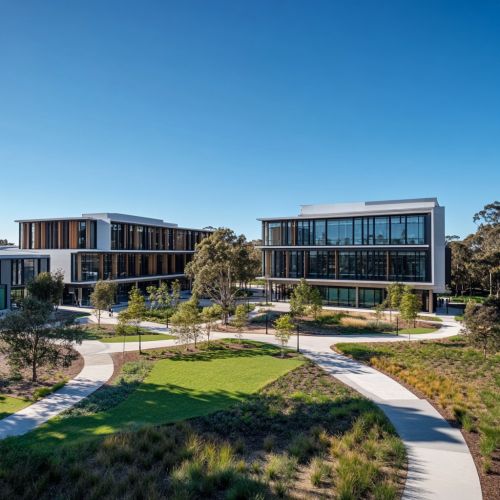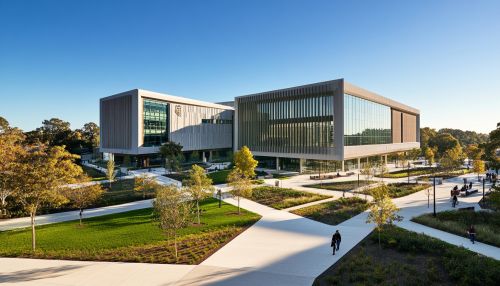Campus Development Plan: Difference between revisions
(Created page with "== Introduction == A '''Campus Development Plan''' is a strategic framework that guides the physical growth and development of a university or college campus over a specified period. This plan encompasses a wide range of considerations including land use, architectural design, infrastructure, sustainability, and community integration. The objective is to create a cohesive and functional environment that supports the institution's educational mission, enhances the studen...") |
No edit summary |
||
| Line 25: | Line 25: | ||
Sustainability is a key focus in contemporary campus development plans. This involves the integration of [[green building]] practices, renewable energy sources, and sustainable landscaping. Environmental considerations also include the management of natural resources, waste reduction, and the promotion of biodiversity on campus. | Sustainability is a key focus in contemporary campus development plans. This involves the integration of [[green building]] practices, renewable energy sources, and sustainable landscaping. Environmental considerations also include the management of natural resources, waste reduction, and the promotion of biodiversity on campus. | ||
[[Image:Detail-99861.jpg|thumb|center|A modern university building surrounded by green spaces and walkways under a clear blue sky.|class=only_on_mobile]] | |||
[[Image:Detail-99862.jpg|thumb|center|A modern university building surrounded by green spaces and walkways under a clear blue sky.|class=only_on_desktop]] | |||
=== Community Engagement and Integration === | === Community Engagement and Integration === | ||
Latest revision as of 16:57, 2 November 2024
Introduction
A Campus Development Plan is a strategic framework that guides the physical growth and development of a university or college campus over a specified period. This plan encompasses a wide range of considerations including land use, architectural design, infrastructure, sustainability, and community integration. The objective is to create a cohesive and functional environment that supports the institution's educational mission, enhances the student experience, and accommodates future growth.
Historical Context
The concept of campus planning dates back to the establishment of early universities, where the layout and architecture were designed to reflect the institution's values and educational philosophy. Over time, campus development has evolved to address changing educational needs, technological advancements, and societal expectations. The University of Virginia, designed by Thomas Jefferson, is a notable example of early campus planning that integrated architectural aesthetics with educational ideals.
Components of a Campus Development Plan
Land Use and Zoning
Land use planning is a critical component of a campus development plan. It involves the allocation of space for various functions such as academic buildings, residential areas, recreational facilities, and green spaces. Effective land use planning ensures that the campus is organized in a way that promotes accessibility, safety, and efficiency.
Architectural Design
Architectural design plays a significant role in shaping the campus environment. It involves the creation of buildings and spaces that are not only functional but also aesthetically pleasing and reflective of the institution's identity. Modern campus architecture often incorporates sustainable design principles, such as energy efficiency and the use of environmentally friendly materials.
Infrastructure and Transportation
Infrastructure development includes the planning and construction of utilities, roads, and transportation systems. A well-designed transportation network facilitates the movement of people and goods within the campus and connects the campus to the surrounding community. This may include pedestrian pathways, bicycle lanes, public transit options, and parking facilities.
Sustainability and Environmental Considerations
Sustainability is a key focus in contemporary campus development plans. This involves the integration of green building practices, renewable energy sources, and sustainable landscaping. Environmental considerations also include the management of natural resources, waste reduction, and the promotion of biodiversity on campus.


Community Engagement and Integration
A successful campus development plan considers the relationship between the institution and the surrounding community. This includes engaging with local stakeholders, addressing community concerns, and fostering partnerships that benefit both the campus and the broader community. Community integration may involve shared facilities, public events, and collaborative projects.
Planning Process
Vision and Goals
The planning process begins with the establishment of a clear vision and set of goals that align with the institution's mission and strategic objectives. This vision serves as a guiding framework for all subsequent planning activities.
Stakeholder Involvement
Engaging stakeholders is crucial to the success of a campus development plan. Stakeholders may include students, faculty, staff, alumni, local residents, and government officials. Their input helps to identify needs, priorities, and potential challenges.
Data Collection and Analysis
Data collection and analysis are essential for informed decision-making. This involves gathering information on current campus conditions, enrollment projections, space utilization, and environmental factors. Analytical tools such as geographic information systems (GIS) may be used to visualize and assess spatial data.
Master Planning
The master plan is a comprehensive document that outlines the proposed development strategy. It includes detailed plans for land use, building design, infrastructure improvements, and sustainability initiatives. The master plan serves as a blueprint for future development and is typically reviewed and updated periodically.
Implementation and Evaluation
Implementation involves the execution of the development plan through construction projects, policy changes, and operational adjustments. Ongoing evaluation is necessary to assess progress, address challenges, and make adjustments as needed. Performance metrics and feedback mechanisms are used to ensure that the plan remains aligned with institutional goals.
Challenges and Considerations
Financial Constraints
One of the primary challenges in campus development is securing adequate funding. Development projects require significant financial investment, and institutions must balance competing priorities within limited budgets. Funding sources may include government grants, private donations, and revenue from tuition and fees.
Regulatory Compliance
Campus development must comply with a range of regulations and standards, including zoning laws, building codes, and environmental regulations. Navigating the regulatory landscape requires careful planning and coordination with relevant authorities.
Technological Advancements
Rapid technological advancements present both opportunities and challenges for campus development. Institutions must consider the integration of new technologies in building design, infrastructure, and educational delivery. This includes the incorporation of smart building technologies and digital learning platforms.
Cultural and Historical Preservation
Preserving the cultural and historical heritage of a campus is an important consideration in development planning. This involves maintaining and restoring historic buildings, landmarks, and landscapes while accommodating modern needs.
Future Trends in Campus Development
Smart Campuses
The concept of a smart campus involves the use of digital technologies to enhance the campus environment. This includes the deployment of Internet of Things (IoT) devices, data analytics, and artificial intelligence to improve operational efficiency, safety, and the overall student experience.
Sustainability and Resilience
Future campus development will continue to prioritize sustainability and resilience. This includes designing buildings and infrastructure that can withstand climate change impacts and promote long-term environmental stewardship.
Flexible Learning Spaces
As educational delivery methods evolve, there is a growing demand for flexible learning spaces that can accommodate a variety of teaching styles and learning activities. This includes the creation of collaborative workspaces, technology-enhanced classrooms, and outdoor learning environments.
